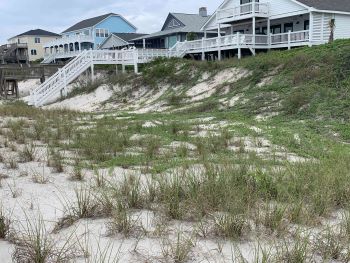Beach Vitex Invades the Carolina Coast
Beach vitex (Vitex rotundifolia) is a deciduous, woody vine from Japan and Korea that was introduced to the southeastern US in the mid-1980s for use as an ornamental landscape plant as well as for sand dune stabilization. Beach vitex is escaping cultivation along the coast of North Carolina and South Carolina and blankets a number of oceanfront dunes along our coast. Because of its invasive nature, beach vitex crowds out native dune plants such as sea oats, American beachgrass and seaside panicum. In addition to threatening our natural sand dune communities, beach vitex also threatens endangered loggerhead sea turtle nesting habitat as well as habitat for the federally threatened seabeach amaranth and other rare plants and animal species.
Beach vitex has several qualities that are common to many invasive species. It is a prolific seed producer. Birds and squirrels eat the fruits and may distribute seeds to other areas where they may germinate and form new colonies of beach vitex. Seedlings and isolated plants believed to have originated from seeds have been observed on beaches throughout the Carolinas. In addition, high tides have been known to break off sections of beach vitex stems. These stems float away and then wash up on other beaches where they may take root and form a new colony. Beach vitex clippings, discarded as yard waste, have been chipped up and spread as mulch. Seeds and cuttings in the mulch have started new populations where the refuse was disposed.
The NC Beach Vitex Task Force was established in February 2005 in order to document existing beach vitex locations and control its spread along the NC coast.
What can you do to help?
- Do not plant beach vitex.
- If removal of beach vitex is not a short term option, consider the following:
- Remove ripe fruits before they are dispersed by birds or water.
- Trim back branches that may break off and float away.
- Put all beach vitex clippings in a plastic trash bag so they will go to the landfill, rather than be chipped and spread as mulch.

The Town of Topsail Beach has invested money to strengthen our beaches through native plant establishment on our beachfront. This investment is being threatened by Beach Vitex. Our Beach Inlet Sound (BIS) Committee strongly recommends agressive removal of this invasive plant species.
Coastal Transplants recently conducted a survey to identify areas along the ocean front properties where Beach Vitex is growing. Below is the survey listing addresses in our community that have Beach Vitex.
BEACH VITEX LOCATIONS IN TOPSAIL